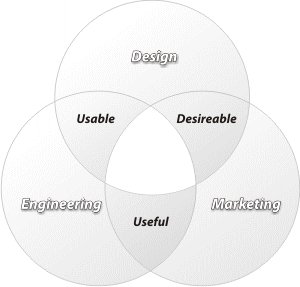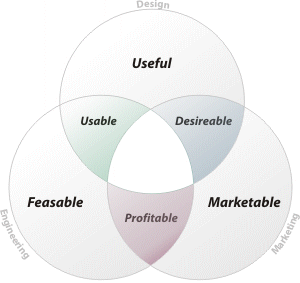I have for a long time believed in the integrated new product development (iNPD) model Jonathan Cagan and Craig Vogel present in “Creating Breakthrough Products.†This model shatters traditional functional silos in favour of a balanced integration between the design, engineering and marketing disciplines. This integration results in products of higher value, and therefore higher likelihood of market success, by consistently improving usability, utility and desirability (Cagan and Vogel say usefulness where I say utility). These improvements are not coincidental but the necessary consequences of integrating these disciplines.

Unfortunately it hasn’t always been possible or practical to follow this model. However, when and where I have been able to follow it I have achieved remarkably better team dynamics and better results. That said I have started to recognize some faults in the iNPD model.
The first fault is that this iNPD model describes the fundamental issues occurring at the intersections between the design, engineering and marketing discipline, but overlooks the issues fundamental to each individual discipline.
The second fault I see is that Cagan and Vogel situate utility at the intersection of engineering and marketing. This certainly creates a pleasant symmetry, but I have the growing suspicion that this symmetry is forced and distorts the case both as it is and as it should be.
In my experience engineering is largely agnostic to a product’s utility, as long as a product development presents interesting engineering problems to solve. And marketing cares about utility only as a means to sell more products with higher gross margins; if a useless product proves attractive to the marketplace so be it.
Design on the other hand, as a problem solving endeavour, is primarily concerned with utility. Indeed many of our more powerful methods (contextual inquiry, task analysis, shadowing, personas, to name just a few) focus on helping to discover what users should find the most useful.
This then begs the two questions: 1) what should we find at the intersection of engineering and marketing? And 2) what are the primary concerns of engineering and marketing? Not having a formal background in either discipline I could be on rather thin ice, but I’m going to try to answer these questions anyway.
I’ll start with the second question first. While design is primarily concerned with questions of product utility, it seems that engineering is primarily concerned with questions of product feasibility and marketing with questions product viability.
To address the first question, while engineering can speak to development costs, and marketing can speak to pricing, together they can address questions of profitability.

I think we can map each of these areas of concern to specific questions that should drive each disciplines’ contributions to product development.
Usability: can our customers use this product?
Utility: does this product alleviate our customers’ pains?
Desirability: do our customers want this product?
Viability: will this product sell sufficiently well?
Profitability: can we make sufficient money selling this product?
Feasibility: can we build this product?
Further questions:
- iNPD was created for product development, and not product innovation; is this model as relevant or valuable to innovation as it is to development?
- Is it going too far to reduce each discipline’s primary concern to single word? Or is it sufficiently clear that each word opens up to a web of related concerns?
- Have I mischaracterized the engineering or marketing disciplines?
I think you have it spot on. Great job!……..and sorry for the late comment